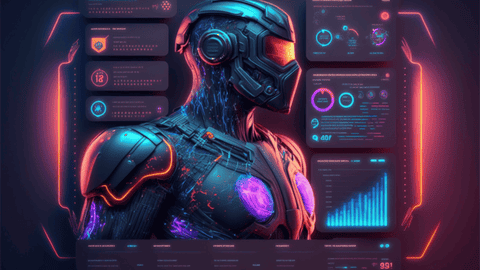In 2023, generative AI for graphic design got better. But it still has some problems. Here’s a quick look at how things are now.
AI-Generated Graphic Design
AI-generated visual designs have come a long way since their debut. Notably, AI like DALL-E, Midjourney, and Adobe’s Firefly make nice visuals.
These AI systems have been used to create artwork, posters, banners, and other visual elements, showing their promise in a variety of sectors.
Research suggests that AI-generated designs can compete with those created by human designers. But there is one thing we should consider – we should give clear prompts and parameters. Vinci, a known AI design system, has matched human designers in certain tasks.
AI Makes Art. How?
AI in graphic design uses neural networks for visuals. These networks are trained using large datasets of photos and designs. Training means AI copies data designs, and then improves to match real ones. Rules can help guide it.
Human designers are crucial in developing effective prompts and teaching the AI to produce the desired results. The wording of prompts and the quality of human support have a significant impact on the quality of AI-generated designs.
Current Limitations of AI Models
AI models in design have limits. Some of the difficulties they face include
- Specialization: AI like Vinci specializes, limiting broad design. Diversity needs diverse training.
- Font-face design: AI may lack font skills, limiting adaptability.
- AI errors: Sometimes AI creates flawed designs. Humans must oversee.
The Role of Human Designers
Graphic designers aren’t fading away because of AI. They adapt by using AI as a tool in their work. Designers know AI saves time, especially for tasks like planning and writing. To compete, they improve by creating good AI prompts and guiding AI well.
But copyright and legal issues for AI-made art are changing. This brings challenges for creators and firms. Clear rules are needed for ownership and rights in this new area. Designers must stay alert and learn to protect their work and ideas as the rules evolve.
The Future of AI in Graphic Design
We think AI in graphic design will play a bigger role in the future. Adobe and other software firms are building AI capabilities into their products, making them more accessible to designers. But we are also sure that though AI can help with some design tasks, AI can’t replace human creativity, instinct, or judgment. Designers who embrace AI as a creative tool and harness its power are likely to remain key contributors to the industry.
Types of AI Graphic Design Tools
Generative design tools: Tools like DALLE 2 and Midjourney create graphics based on user input, often producing artwork quickly.
AI-enabled design tools: These tools help designers work better by making it easier to pick colors, convert CSS, and create brand kits.
Impact on the Design Industry
Graphic designers are adapting to incorporate AI tools into their workflows to reduce the burden of repetitive tasks. The demand for original graphics is outpacing that for stock photography. AI plays a key role in assisting designers, from removing backgrounds to altering facial expressions and basic photo enhancements. AI also simplifies the research and exploration phase by generating multiple design templates for experimentation. This integration of AI into the graphic design process increases efficiency and creativity while meeting the growing demand for unique visual content.
Benefits of AI in Graphic Design
Save time: AI can perform tasks such as background removal and basic image editing in minutes that previously took hours.
Accuracy: AI uses data for precise color suggestions, saving designers time picking colors.
Cost-effectiveness: AI programs often offer competitive pricing, which can result in cost savings compared to hiring expert designers.
Considerations
Think about legal matters: Copyright laws may not cover AI-made stuff, so who owns and uses it? Make sure humans help with touchy design jobs. Also, consider owning: AI art might not mean you own it, so be careful when using it. And remember program rights: Some AI tools say they can reuse your designs, so think about how they’re used.
Examples of AI Graphic Design
AI helps graphic designers by simplifying the creative process. It uses existing brand elements such as images, text, and visuals to create new visuals, saving time and maintaining brand consistency.
Color selection, which is important in design, is made easier with AI tools like Khroma. They create beautiful color combinations based on what users like, making design decisions easier.
AI also handles basic image changes such as removing backgrounds, adjusting faces, and enhancing skin. This makes work faster and more efficient.
AI works with designers, as seen on the cover of Cosmopolitan magazine, where it helps create visuals based on what people want.
AI is also useful for keeping visual themes consistent across platforms, whether it’s brand identity or event themes. This makes it easier for designers to explore and implement ideas, making AI a useful tool in graphic design.
Wrapping up
Designers are leaning on AI to generate various designs from one source. Quick changes with AI are becoming usual. AI supports design by aiding with routine work, suggesting colors, and inspiring designs.
AI is becoming more vital for graphic makers. It adds tons of features, helping and improving creativity. This wrap-up gets the main points of AI tools in your paper. It shows how they matter in making design skills better.
